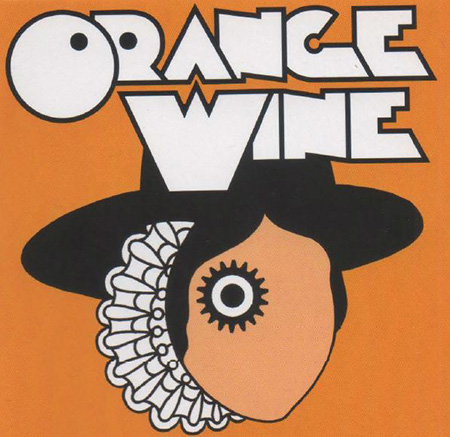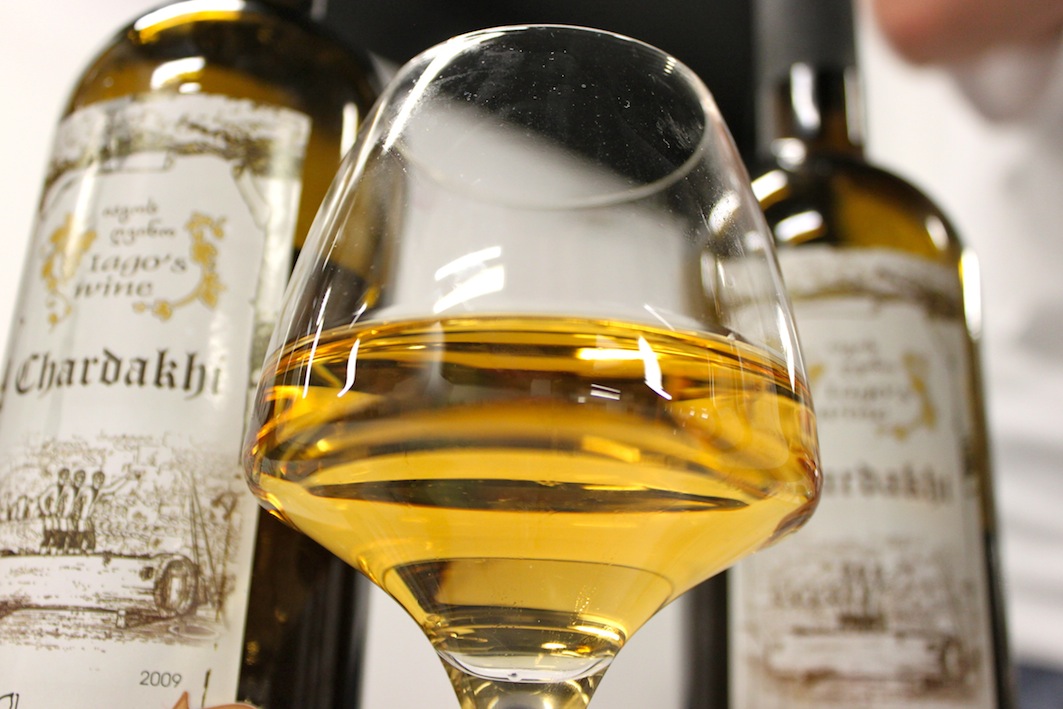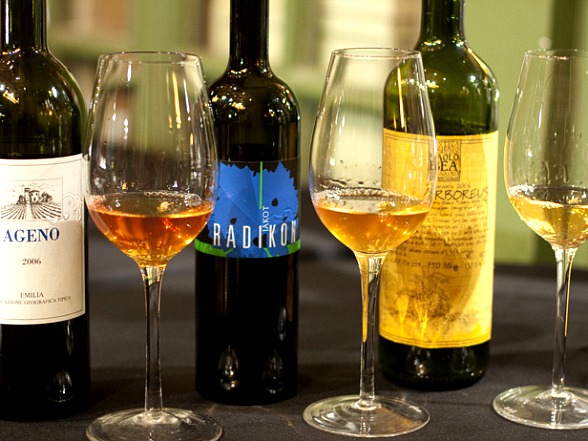Amber in the pink of condition

The beautiful thing about orange wines is that they have pushed the dial in different directions, both forward and back; They show us that wine is more than simple fruity aromas and flavours; it can possess a tactile quality as well.
Every few years, a natural phenomenon occurs, possibly to do with weather or breeding cycles. You might notice a big increase in the number of ladybirds, cabbage whites or flying ants, for example. In a similar way, natural wine as a topic emerges from its dormant/chrysalis state and buzzes into the consciousness of the wine commentariat. The death of natural wine has been prophesied since the moment we first became aware of its existence. As a thing. To be fair, the naysayers and doom-mongers have always had a vested interest in the demise of natural wine, since they never bought into it in the first place. If there is one thing in life worse than being on trend, it is being off trend. (Oscar W, you spoil us.)
Just because people aren’t talking about something, doesn’t mean that it isn’t flourishing. The majority of wine magazines scarcely mention the phenomenon of natural wine, yet social media is still mad for it. I haven’t had conversations about Australian Cabernet Sauvignon, Napa Valley wines or Champagne brands for a decade at least, but I am sure they are getting on fine without me.
Natural wine as a topic emerges from its dormant/chrysalis state and buzzes into the consciousness of the wine commentariat. The death of natural wine has been prophesied since the moment we first became aware of its existence.
When a customer of Les Caves asked me for my opinion about the current “orange” wine scene, so to speak, I had to confess that I had not thought about it that much recently. In the early days of any new wine trend, people fixate on the trend for the very reason that it is a trend. Rather than revealing an eternal truth about the zeitgeist, the trend becomes the social media watercooler topic de nos jours. I lost count of the number of “What is orange wine” articles published in wine magazines. S0me astute individual will pick and run with it, act as the hierophant explaining the whys and wherefores, by elucidating the mysteries, and placing the trend in some sort of cultural context. In this case, Simon Woolf, became the master of all things orange, and wrote an excellent, well-researched book on the subject.

Once niche and oddball, orange wines are now a proven, as they say, and thriving.
Nevertheless, enough time has elapsed since their vinous charms first imprinted themselves on our collective consciousnesses to cobble together a brief state-of-the-amber-nation blog on the subject.
I don’t want to exhaustively recap the history of the skin-contact wines, other than to say that the stirrings of the amber revolution originated (in its modern incarnation) around the turn of the 21st century. Orange wines were, of course, already being made and drunk in various European countries, as well as the Caucasus region. Ramato Pinot Grigio was a bit of thing, but in terms of commercial impact and international recognition, it was Gravner (influenced by his travels in Georgia), Radikon and the Oslavian fraternity that gave this style of wine its notoriety.
(Incidentally, I remember sharing a bottle of Gravner’s Ribolla with a friend in a Soho restaurant, and, seeing three well-known members of the wine trade dining there, offered them a glass each of the bottle. They demurred, shaking their collective heads – Gravner has really lost his way, said one scornfully.)
For me, however, the wine was extraordinary and elemental. Multi-layered, texture of corduroy, rich in tannins, a wine in motion. As when tasting other deep-coloured amber wines, I suspended judgement based on critical orthodoxy, so that I could appreciate the wine with a properly receptive palate.
I lost count of the number of “What is orange wine” articles published in wine magazines.
The wine, and others like it, embodied a pure form of truth too. When Anton van Klopper (Lucy Margaux Wines) and Tom Shobbrook harvested the same Sauvignon grapes from a vineyard in the Adelaide Hills, they went on to make wines which reflected their very different views of what you could/should do with those grapes. (Tom made the skin-contact version, by the way). The amber version of the Sauvignon in question was not right or wrong. It was an active choice, an interpretation of source material, as it were.

When Georgia began to open up and welcome wine visitors, interest in – and appreciation of – amber wines reached another level. Sommeliers and wine buyers from all over journeyed there to learn about the origins of wine civilisation. Many fell in love with the authentic, raw amber liquids they were tasting. Vignerons also made pilgrimage and returned home enthused to make their own interpretations of skin-contact wine.
Skin-contact wine became very much part of the overall natural wine scene. For many, more than a technical approach, it was an assertion of a new (old) style. Not every example worked equally well, of course; in the early days, there was more than a fair share of over-extracted, astringent amber wines that lacked drinkability. Over the years, the spectrum of styles has significantly increased. Objectives have changed, methods have changed accordingly. We have moved slightly away from a bald assertion of “orangeness” to something more subtle, with many different “skin tones.” Skin-contact is being used more and more as a seasoning, a means of adding natural mouthfeel to wines.
As when tasting other deep-coloured amber wines, I suspended judgement based on critical orthodoxy, so that I could appreciate the wine with a properly receptive palate.
It has been suggested that amber wines reveal less terroir character than other wines. In other words, the very method itself obscures the pristine expression of vintage and climate. Skin-maceration undoubtedly confers an extra layer to a wine’s make-up. If done well, it amplifies the terroir signature; if clumsily, then it muffles it. The same could be said about oak or indeed fermentation and maturation vessels, in general, the use of lees, racking, filtering and so forth. The argument that proponents of skin-maceration use with some justification is that over the course of a vintage since the physiology and structure of the grape is so fundamentally transformed, that it seems counter-intuitive when red/blue/purple grape skins may be used in winemaking to take advantage of the very properties they contain, that golden/amber/orange skins are automatically discarded.
How are skin-contact wines perceived in the trade? We’ve been shipping examples of these wines since around 2005/6, and now have considerably over one hundred which might be termed amber. They range from quite pretty fruity and floral wines, to full-on structured, meaty, and tannic versions. And the whole gamut in-between. Some make skin-contact wines as a homage to producers that influenced them on their journey; others because they feel that macerating the juices with the skins expresses the full potential of those grapes. In certain regions, vignerons are acknowledging tradition, whilst searching for original aroma and flavour profiles.
In the early days of Terroirs (2008-9), I recall turbid and funky amber wines going out in carafes. Once when a customer expressed his alarm at the weird beaten copper hue of La Stoppa’s Ageno, another customer at an adjacent table leaned across and said (helpfully): “That is what is called an orange wine. It is a white wine, made like a red, by macerating the grapes with their skins.”
I couldn’t have put it better myself.
This story illustrates that orange wine was a real novelty not so long ago. With the growth of natural wines, it is now a commonplace. This is not just about trendiness, but a momentum shift away from clean-skin winemaking where white wines were treated as the pure opposite of reds. Yet, all the colour certainties are changing. For the artisan winemaker, so called white grapes provide the opportunity to be creative and play with different levels of extraction and tonal variations.
We’ve been shipping examples of skin-contact wines since around 2005/6, and now have considerably over one hundred which might be termed amber. They range from quite pretty fruity and floral wines, to full-on structured, meaty, and tannic versions. And the whole gamut in-between.
Skin-contact wines merit a whole shelf in a shop or a section on a wine list devoted to them. This would denote a basic recognition that they have their due place. But it might also serve to categorise skin contact wines as a different species of wine and one that needs to be kept separate to keep it easy for consumers. Moving away from the simplistic coding of wines by dint of colour towards stylistic considerations would give us a deeper insight into what wines actually consist of. Our senses can perceive wine in multiple shades and dimensions; matt colour is the least of these.
Is the future bright for orange wines? (That sentence had to write itself!) Well, before I answer that, I need to acknowledge (belatedly) that orange is an imperfect way of describing the family of wines made in this style. Amber is not much better. Skin-contact is also quite vague. It doesn’t actually matter, and I swap between these descriptors willy-nilly. We are forever using shorthand in the trade to denote a wider family of wines. White wines and red wines are also shorthand, after all.
Questions about the future success presuppose that current trends are somehow a deviation from past certainties. Yet, orange wines have been around for centuries, perhaps even thousands of years. There is no inviolable law which decrees that wine must be made this way or that. The wheel forever turns, the counterweight constantly comes into play. When CDs were invented, that was the death of vinyl. Except that it wasn’t. And now CDs are becoming a thing of the past. When pasteurisation was used to ensure stability and homogeneity, that was the death of cloudy apple juice, unpasteurised cheese, beer and so forth. It wasn’t. For all that there is a market for consistent produce, there is always going to be a market for authentic, natural, unfiltered, unprocessed and singular. The beautiful thing about orange wines is that they have pushed the dial in different directions, both forward and back. The other beautiful thing about well-made orange wines is that they show us that wine is more than simple fruity aromas and flavours; it can possess a tactile quality as well. Once you taste an orange wine that you enjoy, your palate may become reconfigured, and when you taste other wines, you may start looking for texture.
*
Interested in finding out more about the 100+ skin contact wines that we import? Contact us directly:
shop@lescaves.co.uk | sales@lescaves.co.uk | 01483 538820



Lovely post, Doug. The last sentence is so true, and there were a number of lovely orange wines in yesterday’s tasting. In Pasadena last year, I went into Total Wine and said ‘I’m looking for skin contact’: the slightly flummoxed staff member took a moment to realise I was talking about orange wine 🙂
Pingback: Skinning Up: An interview on the Wine Blast podcast with Susie and Peter – Les Caves de Pyrene